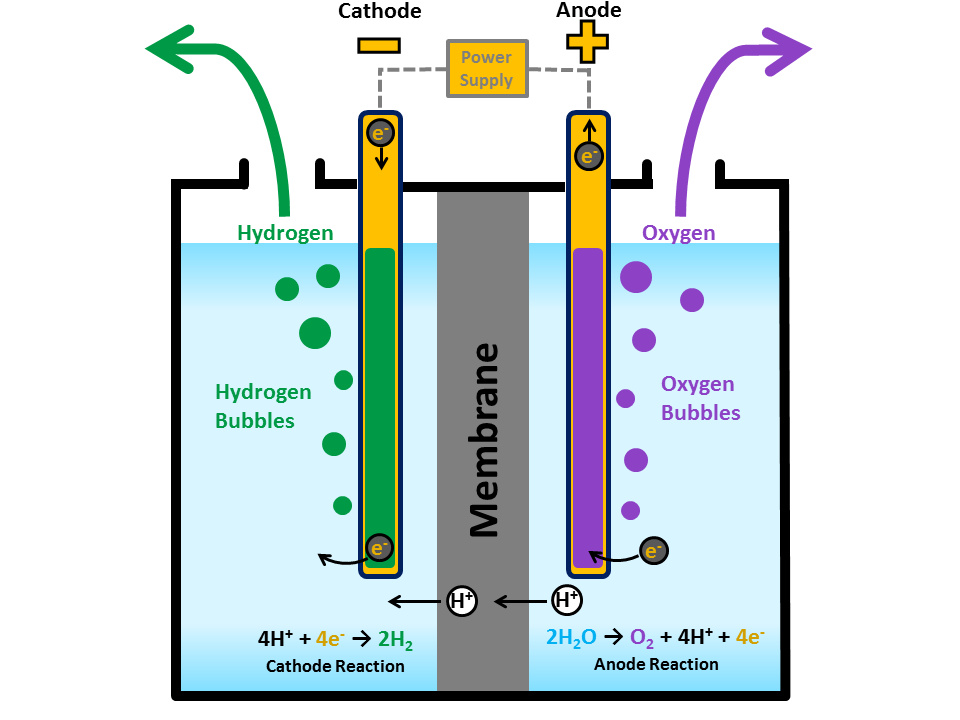Hydrogen electrolysis is a promising technology that plays a crucial role in the transition to clean and sustainable energy. It offers a pathway to produce hydrogen, a fuel that, when used in fuel cells, emits only water and heat. This makes it a key player in reducing carbon emissions and combating climate change. One of the leading advancements in this field is GreenH Electrolysis, which has introduced significant innovations aimed at improving the efficiency, scalability, and affordability of hydrogen production.
What is Hydrogen Electrolysis?
Hydrogen electrolysis is a process that uses electricity to split water (H₂O) into hydrogen and oxygen. This reaction occurs when an electric current passes through water, separating the molecules into their individual components. The basic reaction can be represented as follows:
2H₂O → 2H₂ + O₂
This process has the potential to utilize renewable energy sources, such as wind or solar power, to produce green hydrogen. Green hydrogen is crucial in reducing reliance on fossil fuels, as it doesn’t emit carbon dioxide when burned. This makes hydrogen electrolysis a vital component in the transition to clean energy.
The Role of GreenH Electrolysis
GreenH Electrolysis stands out in the field of hydrogen production due to its innovative approach to optimizing electrolysis technology. The main goal of GreenH Electrolysis is to create more efficient, cost-effective systems for hydrogen production. By making improvements in both the technology and infrastructure, GreenH Electrolysis aims to accelerate the adoption of hydrogen as a clean energy source.
One key innovation of GreenH Electrolysis is the development of advanced membrane electrode assemblies (MEAs). These components play a crucial role in electrolysis, acting as a barrier that separates the hydrogen and oxygen gases during the process. GreenH’s MEAs are designed with cutting-edge materials that enhance conductivity, allowing for more efficient energy conversion. This innovation helps to reduce energy loss and increases the overall efficiency of the electrolysis process.
Another significant advancement from GreenH Electrolysis is the focus on improving the durability of electrolyzer systems. Electrolysis systems often face challenges related to long-term performance, such as material degradation and heat management. GreenH has introduced advanced coatings and cooling techniques to address these issues, ensuring that electrolyzers can operate reliably over extended periods. This improves both the efficiency and lifespan of the equipment, making hydrogen production more sustainable.
Additionally, GreenH Electrolysis is working on scaling up the production capacity of their systems. Traditional hydrogen electrolysis setups have often struggled to match the growing demand due to limited scalability. GreenH’s innovations include modular designs that allow for easy expansion and integration into various industrial applications. This scalability is crucial as it enables the widespread deployment of hydrogen electrolysis systems in different regions, ranging from small local projects to large-scale industrial uses.
Cost reduction is another area where GreenH Electrolysis has made significant strides. By optimizing the components used in the electrolyzer, such as reducing the amount of precious metals needed for electrodes, GreenH has managed to lower the overall cost of hydrogen production. This is essential in making hydrogen more accessible and competitive with other energy sources. The company’s commitment to cost-effectiveness is helping to drive the broader adoption of clean hydrogen energy.
GreenH Electrolysis also focuses on integrating renewable energy sources with electrolysis systems. Since hydrogen production through electrolysis relies on electricity, using renewable energy like solar or wind power can significantly enhance the environmental benefits. GreenH is developing systems that can efficiently pair with these renewable sources, ensuring that the hydrogen produced is truly green and sustainable.
Benefits of Hydrogen Electrolysis
The adoption of hydrogen electrolysis, particularly innovations like those offered by GreenH Electrolysis, brings numerous benefits. One of the most significant advantages is the reduction in greenhouse gas emissions. By producing hydrogen through water splitting, using renewable energy, the carbon footprint is greatly minimized. This is essential for achieving global climate goals and meeting the Paris Agreement targets.
Hydrogen electrolysis also offers energy storage solutions, as excess renewable energy can be used to produce hydrogen during times of low demand. This stored hydrogen can later be converted back into electricity, providing a stable energy supply when renewable sources are not available. This makes hydrogen a key element in stabilizing the energy grid and ensuring a continuous and reliable energy supply.
Furthermore, hydrogen electrolysis has the potential to decarbonize hard-to-reach sectors, such as heavy industries, shipping, and transportation. These industries have traditionally been reliant on fossil fuels, making it challenging to transition to clean energy. Hydrogen offers a clean alternative that can be used directly as fuel or converted into other energy carriers, such as ammonia or synthetic fuels.
Conclusion
Hydrogen electrolysis, especially through innovations like GreenH Electrolysis, is set to revolutionize the way we produce and use energy. Its ability to produce clean hydrogen using renewable electricity makes it a sustainable solution for reducing carbon emissions and creating a greener future. With advancements in membrane electrode assemblies, system durability, scalability, and cost-efficiency, GreenH Electrolysis is paving the way for a more widespread adoption of this technology. As the world continues to shift towards clean energy, hydrogen electrolysis, driven by innovations from companies like GreenH, will play a crucial role in building a sustainable and resilient energy system.





Comments